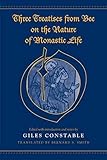Three treatises from Bec on the nature of monastic life / edited with introduction and notes by Giles Constable ; translated by Bernard S. Smith.
Material type: TextLanguage: English, Latin Series: Medieval Academy books ; no. 109.Publication details: Toronto [Ont.] : University of Toronto Press, ©2008 2010)Description: 1 online resource (x, 179 pages : color illustrationsContent type:
TextLanguage: English, Latin Series: Medieval Academy books ; no. 109.Publication details: Toronto [Ont.] : University of Toronto Press, ©2008 2010)Description: 1 online resource (x, 179 pages : color illustrationsContent type: - 9781442689428
- 1442689420
- Bec (Abbey)
- Bec (Abbey)
- Monastic and religious life -- France -- Normandy -- History -- Middle Ages, 600-1500
- Church and state -- France -- History -- To 1500
- Abbeys -- France -- Normandy -- History -- To 1500
- Normandy (France) -- Church history
- Vie religieuse et monastique -- France -- Normandie -- Histoire -- 600-1500 (Moyen Âge)
- Église et État -- France -- Histoire -- Jusqu'à 1500
- RELIGION -- Institutions & Organizations
- HISTORY -- Medieval
- Abbeys
- Church and state
- Monastic and religious life -- Middle Ages
- France
- France -- Normandy
- To 1500
- 271/.10442
- BX2613 .T57 2007eb
- online - EBSCO
| Item type | Current library | Call number | URL | Status | Notes | Barcode | |
|---|---|---|---|---|---|---|---|
 eBook
eBook
|
Biblioteca "Angelicum" Pont. Univ. S.Tommaso d'Aquino Nuvola online | online - EBSCO (Browse shelf(Opens below)) | Online access | Not for loan (Accesso limitato) | Accesso per gli utenti autorizzati / Access for authorized users | (ebsco)468933 |
Includes bibliographical references (pages 168-169) and indexes.
Treatises in English and Latin; introduction in English.
Tractatus de professionibus monachorum = The professions of monks -- De professionibus abbatum = The professions of abbots -- De libertate Beccensis monasterii = On the liberty of the monastery of Bec.
The abbey of Bec was founded in the eleventh century and was one of the best-known and most influential monasteries in Normandy. Celebrated for its high standard of religious life and its intellectual activity, Bec also had an exceptional degree of institutional independence.The three treatises collected and translated in this volume - Tractatus de professionibus monachorum ('The Profession of Monks'), De professionibus abbatum ('The Profession of Abbots'), and De libertate Beccensis monasterii ('On the Liberty of the Monastery of Bec') - are a striking statement of the position of Bec in relation to episcopal and ducal (later royal) authorities. Little is known about the anonymous author of these works except that he was a twelfth-century monk with an attachment to Augustine and Gregory the Great, and that he had considerable knowledge of canon law. His purpose in writing these treatises was to assert and justify the privileges of Bec at a time when many bishops were reacting against monastic freedom, especially with regard to profession.This volume is an important contribution to understanding not only monasticism in Normandy, but also the conflict between church and state in the eleventh and twelfth centuries.


